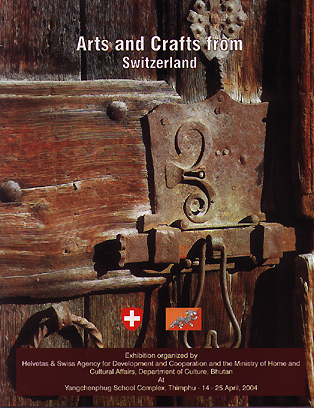| You are here: | HOME > Travel > Bhutan > Topics > Development > Switzerland in Bhutan > Swiss Exhibition > Exhibition | Search |
 |
| Helvetas | Swiss Development Projects |
|
|
 |
| Swiss Exhibition in Bhutan 2004 |
 |
| Beneath
an exclusively modern and urban society famous the world over for its watches
and chocolates Switzerland has a rich traditional culture.
The public in Thimphu are catching a glimpse of this face of Switzerland through a Swiss arts and crafts exhibition which was jointly opened by the foreign minister Lyonpo Khandu Wangchuk and the Swiss ambassador to Bhutan, Mr Walter B Gyger. The two week exhibition showcases some of rural Switzerland's finest works of wooden, ceramic, metal and textile arts never seen or known to most Bhutanese. The
carnival masks
Bhutanese foreign minister Lyonpo Khandu Wangchuk said that the exhibition highlighted the importance that both the countries placed on preservation and promotion of their rich culture and traditions. "The exhibition will serve to promote more appreciation and admiration of the great arts and crafts of the people of Switzerland and inspire further avenues of cooperation and friendship between the people of the two countries." |

|
According to one of the visitors at the exhibition, most of the artifacts on display had their themes drawn from a rural background which was 'remarkably similar' to rural Bhutan.
One of the main attractions at the exhibition are the massive cowbells, cast in Tyrol (Austria), with elaborately decorated leather straps from the largely agrarian society of Appenzell in East Switzerland. According to the organisers, the cowbells were only used during cattle migration to and from the alpine pastures.
The roughly craved wooden carnival masks with animal teeth and horsehair were another exhibit that drew the visitors' attention. The masks are believed to go back a long way although the first written references to them date back only from the 19th century.
According to the organisers, Helvetas, Swiss agency for development and cooperation (SDC) and the department of culture, the exhibition is aimed at providing a better understanding of Switzerland among the Bhutanese.
"I hope that the exhibition will contribute in increasing mutual understanding between Switzerland and Bhutan and increase the friendship existing between our two people and thus contribute to a world of peace and harmony," said ambassador Gyger.
Though formal diplomatic relations started only in 1985, the cooperation between Bhutan and Switzerland date back to the early 1950s when the late King Jigme Dorji Wangchuck and the Von Schulthess family shared a close and personal friendship.
Official Swiss assistance started in 1972 with the first Swiss project on integrated rural development in Bumthang. Helvetas was later established in Bhutan in 1975. Since than, Switzerland has been actively involved in the development of Bhutan's education, culture, rural infrastructure and renewable resources.
| Contributed by KUENSEL, Bhutan's National Newspaper, April 19, 2004 |
|
|
|